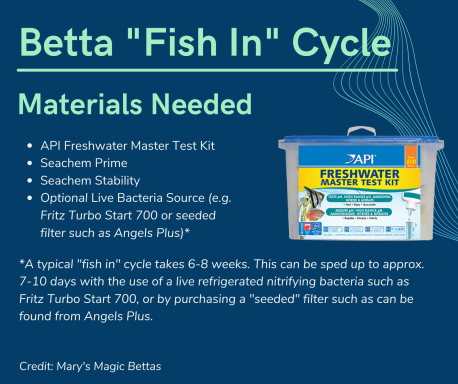HOW TO SAFELY CYCLE A TANK
Every Betta Requires a Cycled Tank!
Cycling a fish tank refers to the process of establishing beneficial bacteria colonies in the aquarium's filter and substrate to create a stable and healthy environment for fish and other aquatic organisms. Cycling is an essential step when setting up a new fish tank or when introducing new fish to an existing aquarium. It helps to establish a biological filtration system that converts toxic ammonia, produced by fish waste and uneaten food, into less harmful substances.
A really simple summary is this: Fish waste, excess food, dying plants, and dying marine life all produce Ammonia. Ammonia is extremely toxic to fish, and should always be keept at 0ppm (parts per million). There are 2 ways to do this. One is to perform frequent 50% water changes for your tank (at least every week for a 5 Gallon tank, even better would be twice weekly 25% water changes). The other way is to have a cycled tank. This means you have a colony of nitrifying bacteria (aka "beneficial bacteria") large enough to "eat" the ammonia. But then, this bacteria produce a waste product known as Nitrites. While these are also toxic to fish, they're less toxic than ammonia. That said, the goal is still 0ppm. Nitrites then convert to Nitrates, which are even less toxic, and should be no higher than 20ppm. Additionally, keeping live plants in your aquarium can also help keep a tank cycled and reduce these chemicals in a tank. Ever looked at a bottle of plant fertilizer? Ammonia, nitrites, nitrates, phosphates...sounds familiar huh? Plants need these to stay healthy, so adding plants to your tank is a win-win for a well-oiled ecosystem. But that's a topic for another post.

Fish-In Cycling:
That said, since bettas are a common "starter" fish, and even betta experts find themselves impulsively acquiring these fish (guilty), a "fish-in cycle" is also an option. While this does come with some risk, there is a safe and fast method of doing a fish-in cycle that I have personally implemented successfully 10+ times. Please see the infographics to the right for details on how to properly perform a fish-in cycle. The goal here is to never allow ammonia and nitrites to go above 0.25 ppm, with 0 always being the goal. I also strongly recommend the use of Fritz Turbo Start or a pre-seeded filter, mentioned above, to speed up the fish-in cycle. Without these items, it can easily take 6-8 weeks or more to fully cycle a tank. That's a lot of daily testing! Another wonderful resource for proper fish-in cycle is provided by Fish Lab: https://fishlab.com/fish-in-cycle/. The facebook group Betta Fish Keepers also has wonderful advice and support for cycling a tank. See more detailed instructions below.
Fishless Cycling:
If you can, it is safest to cycle your tank before adding fish to is. The process is similar to fish-in cycling. Yo'ull need a bacteria, like discussed above, but you will ALSO need to "feed" the tank ammonia. Remember, ammonia is what the bacteria "eats" and in a fish-in cycle, your fish is providing ammonia for the bacteria. In fishless, you need to add ammonia. I recommend using a product like Fritz Fishless Fuel or Dr. Tims ammonia. A cycled tank can process 2ppm of ammonia down to 0 in 24 hours. So you'll want to dose your tank to between 2-3 ppm ammonia, and add your bacteria starter. Continue to feed ammonia and bacteria to the tank until you are consistently seeing 0 ammonia, 0 nitrites, and nitrates at 5ppm or higher. Water change if ammonia gets above 3 ppm as this can stall your tank (as can nitrites and nitrates that are too high).
After your initial ammonia dose to get the tank up to 2-3 ppm, continue measuring ammonia and nitrite every 2 or 3 days until you start to see some nitrite. This is a sign that the ammonia-oxidizing bacteria are starting to work. Add half the initial amount of ammonia you added to the water on day 1. Continue measuring ammonia and nitrite every 2 or 3 days. Around day 9 to 12, the ammonia will probably be below 1 mg/L, maybe even 0, but nitrite will be present. Nitrite does not spike until somewhere between days 14 and 20. You want to be careful adding more ammonia because you do not want the nitrite-nitrogen over 5 mg/L as this will start to poison the nitrite-oxidizing bacteria. Add a little ammonia every few days (1/4 dose), making sure the nitrite does not go above 5 mg/L. Once you start to see the nitrite decrease, it will drop pretty fast. The cycle is completed when you can add the full dose of ammonia (2 to 3 mg/L-N) and overnight it all disappears to nitrate with no sign of nitrite. Now you can start to add fish.
NOTE: Once you do add fish to your tank, test ammonia and nitrites DAILY for at least 1 week, ideally 2. This is because the bacteria colony may need to adjust to the actual bio-load of your fish, so there may be ammonia or nitrite spikes as the colony either grows or dies off, and you'll need to water change to keep these levels at or below 0.25ppm, just like a fish-in cycle.
Water Parameters:
Whether you are doing a "fishless" or "fish-in" cycle, it's very important to test your water parameters daily until you are certain your tank is cycled. The API Freshwater Master Test Kit is by far the most accurate test kit available. It's a little pricey, but it lasts a LONG time and is a good investment for any serious fish keeper. Even once your tank is cycled, it is still recommended to test your water parameters weekly to monitor for any unexpected spikes in ammonia, nitrites, and nitrates, or unexpected changes in pH.
Getting Started With a Fish-In Cycle:
The infographics provided spell out all of the steps of a safe fish-in cycle. But if those are hard for you to read, i've typed it all out here as well.
Materials Needed:
- API Freshwater master Test Kit
- Seachem Prime
- Seachem Stability
- Optional live bacteria source (Fritz Turbo Start 700 or a seeded filter such as from Angels Plus)
- A typical "fish in" cycle takes 6-8 weeks. This can be sped up to approximately 7-10 days with the use of live nitrifying bacteria such as the ones mentioned above.
Instructions For Fish-In Cycling:
- Test water parameters using the API Master Test Kit.
- Test pH and Nitrates 1-2x/week until cycled.
- Test Ammonia and Nitrites daily until cycled.
- If Ammonia or Nitrites go above 0ppm, follow the steps on the chart.
- WC = Water Change
- Prime = Add Seachem Prime and Seachem Stability
- If using Fritz Turbo Start to speed up the cycle:
- If ammonia is above 0ppm, add Fritz Turbo Start in addition to following the instructions on the chart.
- If ammonia is 0 but nitrites are high, don't add more Fritz, but do follow the instructions on the chart.
- Wait 24 hours, go back to step 1
My Tank Cycled. Now What?
- A cycled tank will consistently have 0 ppm Ammonia, 0 ppm Nitrites, and 0-20 ppm Nitrates with no spikes for 5+ days.
- Note, you will only see 0 ppm Nitrates in a cycled tank that is heavily planted with live plants.
- Once parameters indicate a cycled tank, continue to test ammonia and nitrites daily for 3-5 days to ensure levels stay consistent.
- Once you feel the tank is cycled, continue to test all parameters 1-2 times per week.
- Even when cycled, perform 25% water changes every 1-2 weeks to limit algae growth and introduce new necessary minerals to the water
Other Common "Gotchas":
- Ammonia In Tap Water: If you're doing everything you're supposed to be doing but your tank just won't cycle or you just can't get your ammonia down to 0ppm, or you see a spike every time you do a water change, test your tap water! In fact, I recommend testing your tap water before you do anything else. While this shouldn't be the case, lots of people's tap water contains ammonia! If this is happening to you, be sure to use mineral or spring water for all of your water changes and to fill your tank. You can also invest in a RODI system or use distilled water, but if you do, be sure to manually add minerals back in such as by using Seachem Replenish.
- Don't "Chase" pH: Betta fish can handle a pretty wide range of pH's. While all pH ranges are safe if stable, the ideal range for bettas is 6.5-8.0. What isn't safe is rapidly change pH levels. Trying to manually change your pH can result in unstable pH levels that can be harmful for your fish. So if your levels are anywhere between 6.5 and 8.0, leave them alone (even if you have live plants).
- Test After Fertilizing: If you have live plants, it's important to fertilize your tanks with water column and/or root tab fertilizers once a month. Because plants require things like Nitrites and Nitrates to thrive, sometimes adding these fertilizers can cause a small spike in Nitrites especially. This won't crash your cycle, sometimes your ecosystem just needs some time to catch up to the change, but regardless, it's good to test your parameters daily for a few days after fertilizing so you can catch and respond to any unexpected spikes in ammonia, nitrites, or nitrates.
- Don't Buy Cycled Water: One of the most common pitfalls for new fishkeepers is believeing that if they buy cycled water from a LFS (local fish store) or buy bottles of "betta water" that they'll be fine. This is a huge misconception. All you're doing is buying water that has been conditioned to remove heavy metals and chlorine (btw, you should be adding a water conditioner like Seachem Prime or API Stress Coat EVERY time you add water to a tank!). While ammonia, nitrites, and nitrates live in the water column and can be removed with water changes, beneficial bacteria do NOT live in the water column.They live on surfaces like filters, substrate, and decor. So when you take cycled water from another tank, you aren't taking any of that tank's beneficial bacteria with it.
- You still Need Water Conditioner: Like I mentioned above, every time you add water to your tank, you need to condition your water! My favorites are Seachem Prime and API Stress Coat. Tap water, and sometimes even bottled water, can contain harmful chemicals like chlorine and heavy metals that are unsafe for fish.
- Live Substrate Isn't Enough: Another pitfall is thinking if you use a substrate that isn't inert, or that is "live" like live sand or my personal favorite CaribSea Eco Complete, that your tank will cycle. While these substrates (especially EcoComplete) DO often contain live nitrifying bacteria (and has amazing nooks and crannys for the bacteria to live), they don't contain nearly enough to cycle your tank, and it could take a very very long time for the bacteria colony to grow big enough to support the ammonia produced by your fish.
Learning Curve:
While cycling a tank is arguably the steepest learning curve when first getting into fish keeping, I know you can do it! Think of it like a daily adult science experiment. It can be very fascinating to have complete control over a fully functioning ecosystem, a deeply gratifying when your tank finally cycles and you see those 0ppm ammonia and nitrite readings. Still have questions? Contact us, we're always happy to help!
Click on any of the images below to expand them. Feel free to download and save or share!
We need your consent to load the translations
We use a third-party service to translate the website content that may collect data about your activity. Please review the details in the privacy policy and accept the service to view the translations.





